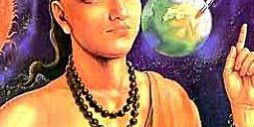Aryabhata (476–550 CE) was the first in the line of great mathematician-astronomers from the classical age of Indian mathematics and Indian astronomy. His most famous works are the Aryabhatiya (499 CE, when he was 23 years old) and the Arya-siddhanta.
He studied at the University of Nalanda. One of his major work was Aryabhatiya written in 499 AD. The book dealt with many topics like astronomy, spherical trigonometry, arithmetic, algebra and plane trigonometry. He jotted his inventions in mathematics and astronomy in verse form. The book was translated into Latin in the 13th century. Through the translated Latin version of the Aryabhattiya, the European mathematicians learned how to calculate the areas of triangles, volumes of spheres as well as how to find out the square and cube root.
In the field of astronomy, Aryabhatta was the pioneer to infer that the Earth is spherical and it rotates on its own axis which results in day and night. He even concluded that the moon is dark and shines because of the light of sun. He gave a logical explanation to the theory of solar and lunar eclipses. He declared that eclipses are caused due to the shadows casted by the Earth and the moon. Aryabhatta proposed the geocentric model of the solar system which states that the Earth is in the center of the universe and also laid the foundation for the concept of Gravitation. His propounded methods of astronomical calculations in his Aryabhatta-Siddhatha which was used to make the the Panchanga (Hindu calendar). What Copernicus and Galileo propounded was suggested by Aryabhatta nearly 1500 years ago.
Aryabhatta’s contribution in mathematics is unparalleled. He suggested formula to calculate the areas of a triangle and a circle, which were correct. The Gupta ruler, Buddhagupta, appointed him the Head of the University for his exceptional work. Aryabhatta gave the irrational value of pi. He deduced ? = 62832/20000 = 3.1416 claiming, that it was an approximation. He was the first mathematician to give the ‘table of the sines’, which is in the form of a single rhyming stanza, where each syllable stands for increments at intervals of 225 minutes of arc or 3 degrees 45′. Alphabetic code has been used by him to define a set of increments. If we use Aryabhatta’s table and calculate the value of sin(30) (corresponding to hasjha) which is 1719/3438 = 0.5; the value is correct. His alphabetic code is commonly known as the Aryabhata cipher.





